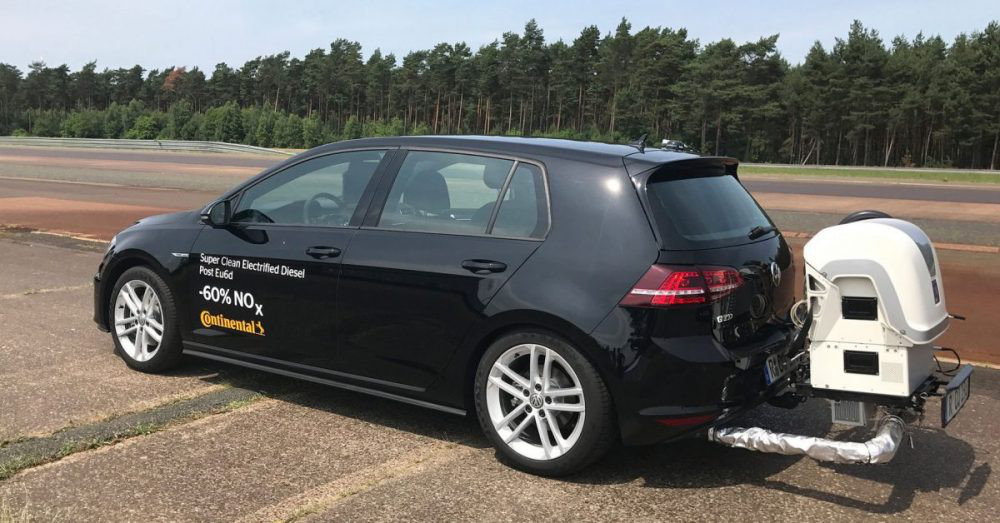Diesel is not dead

THE UK, China, India, plus several other European countries have all announced a ban on the sale of new diesel vehicles from as early as 2025.
Combine this with VW’s now infamous Dieselgate scandal, and it might appear at a glance that diesel is dead. Not so, according to Continental. They recently launched their Super Clean Electrified Diesel system, boldly proclaiming, “Diesel has a future, it’s not dead!”
Why Continental? As well as being one of the world’s biggest tyre manufacturers, Continental is also a technology company, independently developing a range of pioneering automotive technologies. Their goal with Super Clean Electrified Diesel, was to rescue diesel’s tarnished reputation. The system not only reduces Nitrogen Oxides (NOx) by 60 percent, it also reduces CO2 emissions and improves fuel consumption.
The key elements of the system include; proprietary common rail injection system, post-combustion fuel injection, electrically heated catalytic converter and a 48-volt Hybrid power unit.
Continental’s PCRs5 piezo common-rail injection system operates at 2500 Bar (36,000psi) and works in conjunction with highly dynamic valve timing. On cold start-ups, a minuscule amount of fuel is injected into the cylinder after combustion. This fuel ignites at the catalyst, quickly heating it to operating temperature. This results in a 37 percent reduction in NOx (nitrogen oxides) emissions, as they’re much higher during those first few kilometres.
To further reduce emissions, the system is fitted with Continental’s close-coupled electrically heated catalyst to ensure the SCR catalyst is always at optimum operating temperature – ensuring it converts as much of the NOx as possible. This also provides maximum effectiveness for the AdBlue, which is injected immediately downstream of the heated catalyst.
To help power all this and improve overall fuel economy, the standard alternator is replaced with a 48-volt Hybrid charging, recovery and motor unit. Dubbed ‘Mild Hybrid’, the belt-drive unit is capable of energy recovery when coasting, or braking – storing the energy in a small, auxiliary lithium-ion battery. While its modest, in-built 14kW electric motor assists the diesel engine during acceleration – the time at which NOx emissions are highest and when the extra power is needed most. Lastly, Continental simultaneously incorporates their connected Energy Management (cEM) and Traffic Light Assist (TLA) technologies. These two systems use intuitive algorithms that continuously evaluate incoming navigation data such as terrain, traffic conditions, traffic light activity, etc. They maximise the vehicle’s operating efficiency by optimising power recovery and power delivery, thereby generating further fuel and emissions savings.
In total, Continental’s test vehicle recorded a 60% reduction in NOx emissions, along with a 4% improvement in fuel economy (compared to a Euro 6 Diesel standard car) during the real-world city, country and highway driving. Talk about a win, win!
Keen to prove the capability of Super Clean Electrified Diesel, Continental invited prominent motoring journalists from around the globe to test drive a VW Golf fitted with the breakthrough system. Their feedback was overwhelmingly positive.
Ultimately the Continental system was able to reduce NOx emissions to as low as 42mg/km! This is a remarkable result. Even the Golf’s upper level of NOx emissions was well below the tough, new 80mg/km standard being introduced into Europe in 2020.
With figures like these, it’s no wonder Continental are confident that diesel is not dead.
Continental’s electrically heated catalyst (EMICAT)
Electrically heated catalytic converter, incorporating the AdBlue injector (top left)
Continental’s stunning figures are based on measurements taken in real-time, at the tailpipe
Continental’s belt-driven, 48-Volt, Mild Hybrid charging, motor and power recovery unit that takes the place of the alternator
Under real-world, city, country and highway driving conditions, Continental’s Super Clean Electrified Diesel system comfortably exceeds the tough, new diesel emissions standards being introduced in 2020
